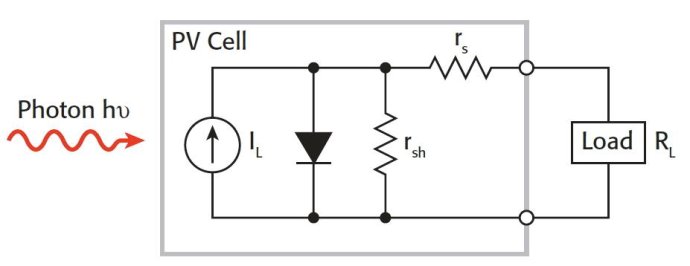PV电池的等效电路模型(如图1所示)能够帮助我们深入了解这种器件的工作原理。理想PV电池的模型可以表示为一个感光电流源并联一个二极管。光源中的光子被太阳能电池材料吸收。如果光子的能量高于电池材料的能带,那么电子就被激发到导带中。如果将一个外部负载连接到PV电池的输出端,那么就会产生电流。
The equivalent-circuit model for a PV cell (Fig. 1) provides some insight into the operation of the device. An ideal PV cell can be modeled as a light-induced current source in parallel with a diode. Photons in a light source are absorbed into the solar cell materials. If the photon energy is greater than the bandgap of the cell material, then electrons are excited into the conduction band. If an external load is connected across the output terminals of the PV cell, current will flow.

图1. 由一个串联电阻(RS)和一个分流电阻(rsh)和一个光驱电流源构成的光伏电池等效电路。
Fig. 1. The equivalent circuit of a photovoltaic cell shows a series resistance (RS) and a shunt resistance (rsh), along with a light-driven current source.
由于电池衬底材料及其金属导线和接触点中存在材料缺陷和欧姆损耗,PV电池模型必须分别用串联电阻(RS)和分流电阻(rsh)表示这些损耗。串联电阻是一个关键参数,因为它限制了PV电池的最大可用功率(PMAX)和短路电流(ISC)。
Because of material defects and ohmic losses in the cell substrate material as well as in its metal conductors and contacts, the PV cell model must also include series resistance (rS) and shunt resistance (rsh) respectively, to account for these losses. The series resistance is a key parameter because it limits the maximum available power (PMAX) and the short-circuit current (ISC) of the PV cell.
PV电池的串联电阻(rs)与电池上的金属触点电阻、电池前表面的欧姆损耗、杂志浓度和结深有关。在理想情况下,串联电阻应该为零。分流电阻表示由于沿电池边缘的表面漏流或晶格缺陷造成的损耗。在理想情况下,分流电阻应该为无穷大。
The series resistance (rs) of the PV cell may be due to the resistance of the metal contacts on the cell, ohmic losses in the front surface of the cell, impurity concentrations, or junction depth. Under ideal conditions, the series resistance would be zero ohms. The shunt resistance represents the loss due to surface leakage along the edge of the cell or due to crystal defects. Under ideal conditions, it would have an infinite value.
要提取光伏电池的重要测试参数,需要进行各种电气测量工作。这些测量通常包含直流电流和电压、电容以及脉冲I-V。
To extract important test parameters about the solar cell, a variety of electrical measurements can be performed. These measurements often include DC current and voltage, capacitance, and pulsed I-V.

 我要赚赏金
我要赚赏金

